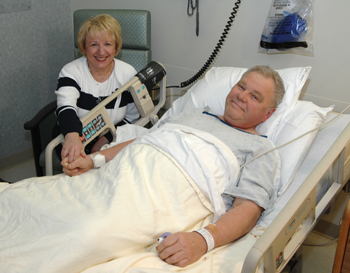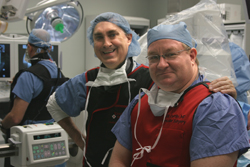
Patient Carl Eisemann, here with his wife, Gabriele, recently underwent a new procedure for carotid artery stenting that reverses blood flow to ease the risk of stroke. (photo by Neil Brake)
System reverses blood flow to ease stent surgery risks

Charles Ross, M.D., left, and Jeffery Dattilo, M.D., are studying the new technique. (photo by Charles Joel Vaughn)
Vanderbilt vascular surgeons are using a new technique for carotid artery stenting (CAS) that reverses blood flow to reduce the risk of stroke during the minimally invasive procedure.
Jeffery Dattilo, M.D., and Charles Ross, M.D., both assistant professors of Surgery, are the principal investigator and co-investigator, respectively, of the EMPiRE (Embolic Protection with Flow Reversal) clinical study, designed to test the safety and efficacy of the GORE Neuro Protection System.
The system has been used abroad with great success and is now being studied in selected centers in the United States. Vanderbilt Heart & Vascular Institute (VHVI) is one of 30 sites offering the procedure.
The surgeons operated on their first EMPiRE patient last week. The patient had a critical blockage of his carotid artery, which is located at the side of the neck and supplies blood to the brain. His blockage placed him at high risk for stroke.
“About 30 percent of strokes are caused by atherosclerotic carotid artery disease. Correction of carotid blockage represents one of the ways to significantly reduce the risk of first-time and recurrent strokes,” Ross said.
To correct the blockage, Ross and Dattilo inserted a sheath/balloon system from the patient's femoral artery in the groin into his carotid artery in the neck. The system was then connected to the patient's femoral vein. Within that connection is a filter. The carotid balloons were inflated, thus creating a natural reversal of flow from the carotid artery to the low-pressure venous system — away from the diseased internal carotid artery and the brain. The surgeons then treated the blockage with balloon angioplasty and stenting.
“With the reversal of flow in the artery, all of the debris or fragments broken loose can be safely filtered out of the system, instead of going toward the brain,” Dattilo said. “This system simply and elegantly takes advantage of the physiology and hemodynamics of most people.”
“It is a novel way of protecting the brain from dislodged plaque, or embolization, during carotid artery stenting,” Ross said. “It represents another step forward in our quest to improve the safety of carotid artery stenting.”
Until this technique became an option for use in CAS, vascular surgeons most commonly threaded a miniscule basket above the blockage to function as a filter. Crossing the lesion itself, however, carried the risk of causing some particles to break free before the basket could be opened. Additionally, in some cases, so much plaque could loosen during balloon inflation that it could completely clog a basket.
“With the new device, blood flow is reversed before the lesion is crossed. This system can also handle large volumes of plaque and debris, thereby reducing the risk of stroke to a minimum,” Dattilo said.
Carotid endarterectomy, an open procedure in which the surgeon removes the plaque surgically, is the “gold standard” treatment for significant carotid artery blockage. It is the second most common vascular operation performed in the country, behind coronary artery bypass.
CAS is an evolving alternative. Patients who may benefit include those at high risk for complications due to co-morbid illness and those at anatomic “high risk” for local complications from surgery (i.e. people who have had previous radiation therapy, head and neck surgery or who have developed a recurrent, carotid stenosis following endarterectomy.)
For CAS to be performed safely, a number of systems have been developed to prevent stroke, and VHVI offers all of them, in addition to optimal medical management and standard open carotid surgery.
“We offer comprehensive therapy, tailored to the individual risk profile and anatomic characteristics of the particular patient and his particular lesion,” Ross said.













